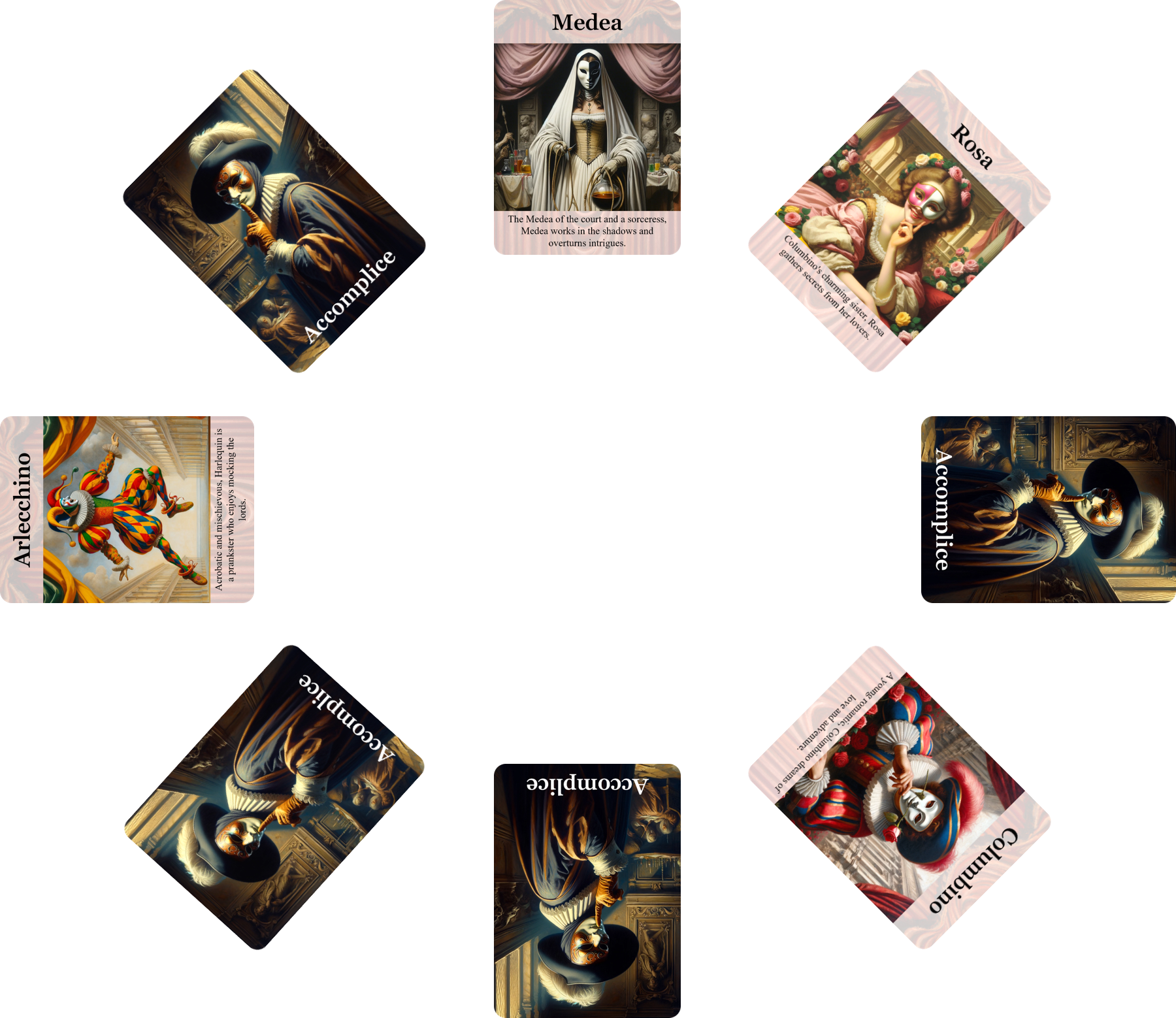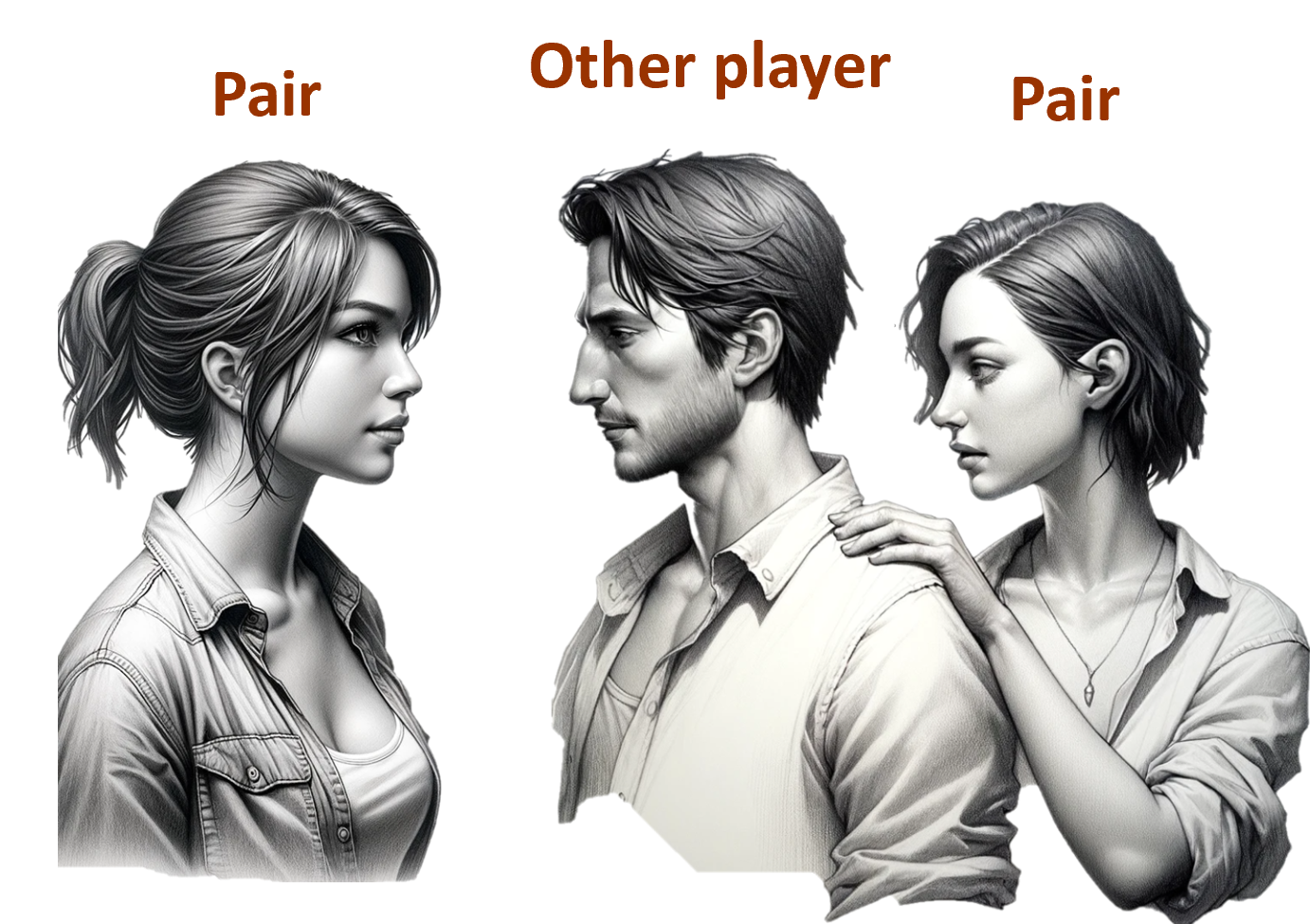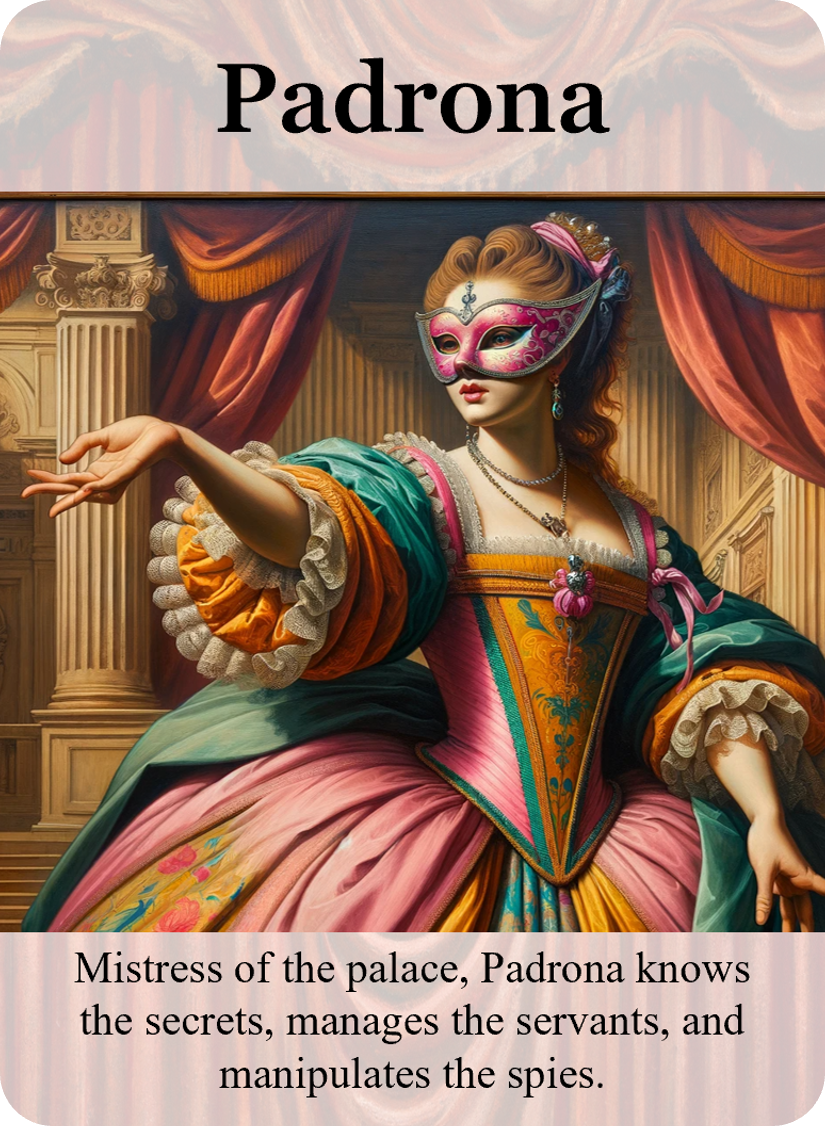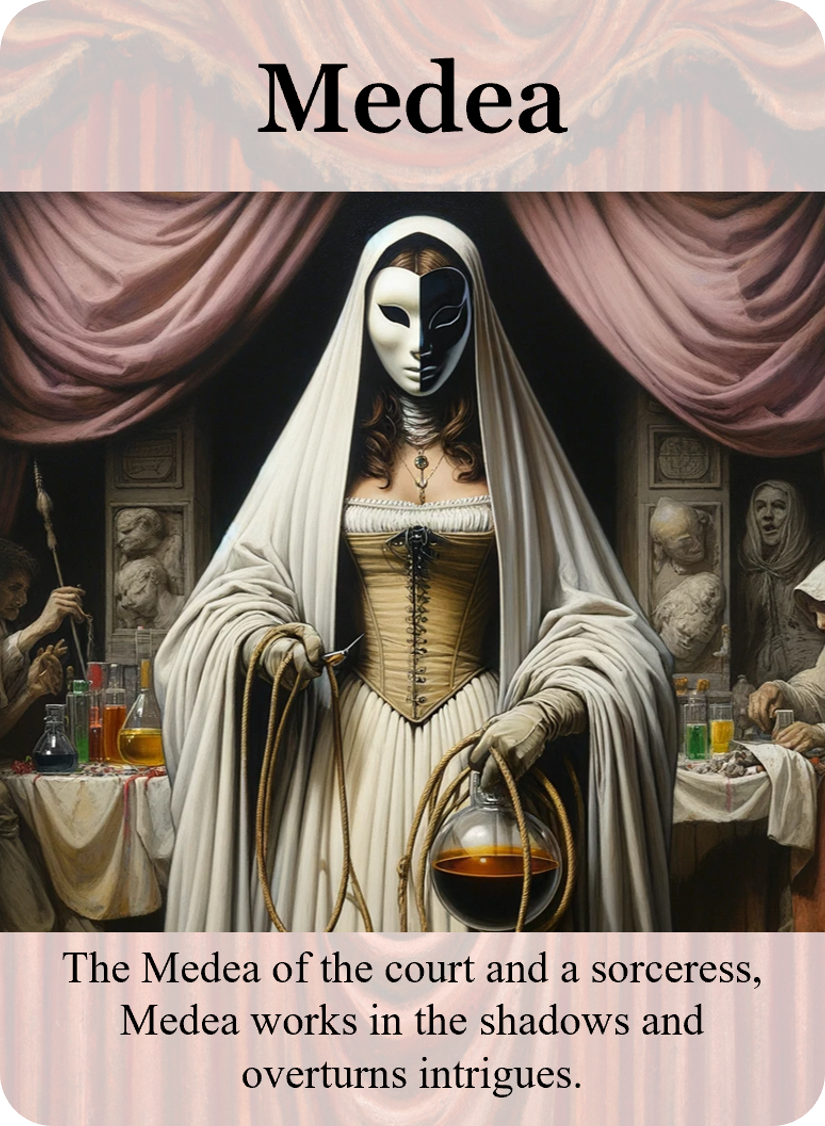The Comedy of Death - Game Rules
In a Few Words...
"Commedia dell'arte", a genre of popular theater from the 16th century that heralded the first masked Italian acting troupes, inspires this first story of Killer Wink: "The Comedy of Death".
The game is very easy to set up, simple to understand, and quickly gets all players involved.
I warmly wish you wonderful evenings full of mystery and murder! And if you'd like to keep the fun going, you'll be happy to know that there are three more games in the first season, each one gradually adding more challenge, in-game events, and strategy.
And now, let the game begin!
Please take the time to carefully read the game rules below. Make sure to explain them clearly to your friends, show them the example images, and don’t overlook anything—every detail is important.
Will Kinker
Requirements
The game can be played with 6 to 18 players, preferably ages 16 and up. However, it also works well with younger players, though they may find it more challenging to stay patient and discreet during the game.
The duration of the game varies from 30 minutes to two hours, depending on the players' skill and patience.

Create the Ambiance
If you want to adapt the theme of your evening, ask your friends to come dressed as Harlequin, Scapino, Pulcinella… and recreate the atmosphere of a 17th-century Venetian salon. Picture yourselves at the Palazzo Aurelio. Arrange small, well-decorated armchairs and a small round table. Add large red and gold curtains. You can even act out scenes and speak to each other in grand, lyrical phrases.
Prepare the Game
You will form secret pairs — you will know your partner, but you won’t know who the other pairs are. Ideally, the number of players should be even, between 6 and 18. (To play with an odd number of players, refer to the last chapter, 'Alternate Versions,' and then continue with the rules below.)
To begin, gather around a table to distribute the cards. But once the pairs are created, the game will unfold throughout your evening—during appetizers, on the terrace, in the kitchen, or while dining. Killer Wink is not played around the table but as a backdrop to your evening.
Take as many "Actor" cards as there are pairs of players. Then, take the "Accomplice" cards corresponding to the characters on the selected "Actor" cards. This will give you as many cards as there are players.
Players with the "Actor" cards will not know their accomplice at the start of the game, while those with the "Accomplice" cards will discover their actor accomplice as soon as the cards are distributed and must inform their teammate during the game. You can either shuffle all the selected cards together and distribute them to the players, or shuffle the two decks separately—giving the "Accomplice" cards to those who want to know their teammate from the start, and the "Actor" cards to the others.
You could also create mixed pairs by giving “Actor” cards to women and “Accomplice” cards to men.
Tell the Story of The Comedy of Death
« Venice, in the year 1610, at the heart of the golden age of the Commedia dell'Arte, buzzes with life and laughter. King Alfonso III, a connoisseur of the arts and a great theater enthusiast, is captivated by the dazzling performance of the exceptional artists in the troupe and decides to honor the masters of the stage by inviting them to his sumptuous palace, the Palazzo Aurelio.
To honor these masters of the stage, he invites them to his sumptuous palace, the Palazzo Aurelio, promising a handsome sum of gold as a reward—a fortune that could change the lives of each troupe member. Under the Venetian moonlight, the Palazzo Aurelio hosts an exquisite gathering of Commedia dell’Arte characters. Masks and costumes glitter in the opulent hall set aside for the artists.
But among them, laughter fades, and smiles conceal secret intrigues when King Alphonse III, in his grand generosity, unveils a chest of gold that shines as brightly as the Venetian sky. The lure of gold sparks secret alliances. Artists form shadowy pairs, duos ready to share the wealth but also prepared to betray for the entire treasure.
Unaware that others share the same goal, the palace becomes a theater of deadly intrigue. The dance begins. Pairs move gracefully throughout the palace, hidden among the shadows. The sinister ritual of death plays out in silent corridors, each “assassination” cloaked in the elegance and subtlety of Commedia dell’Arte.
As alliances break and betrayals are revealed, the golden comedy reaches its climax. Masks fall, laughter turns to silence. The last artists still alive face off in a final duel, intoxicated by the scent of gold. »
Create the Mystery
You’ve just distributed the “Accomplice” and “Actor” cards to the players. Each player looks at their card without revealing it to others, then places it back on the table.

The “Actors” reveal their cards, allowing the “Accomplices” to identify their partner. In turn, each actor flips over their card, announcing their character: “I am…”
Each “Accomplice” can then identify their “Actor” partner by referring to their own secret “Accomplice” card.

At the end of the round, each “Accomplice” can keep their card as proof of identity for their partner. The “Actor” cards can remain on the table.
To simplify the game, you can establish a rule that lying is not allowed when informing your accomplice that you are on their team (see the "Accomplicity" chapter). In this case, it is unnecessary to keep the "Accomplice" cards with you to prove to your teammate that you are on their side. You can return them to the game.
Objective of the Game
Each secret pair’s goal is to eliminate all other players and, ultimately, eliminate their accomplice to be the sole survivor and claim King Alphonse III’s treasure.
Accomplicity
In the first phase, accomplices must inform their secret actor that they are partners working together against everyone else. The accomplice must do this discreetly during the evening. They can show their "Accomplice" card to prove their identity if you’ve decided to keep the "Accomplice" cards on hand. Alternatively, they can communicate it verbally or with a simple wink or knowing look, but both players must clearly understand that they are working together.
Elimination
At the Palazzo Aurelio, eliminations happen in pairs. To eliminate a player, one member of a pair stands behind the target while the other stands in front of them. The player behind places a hand on their shoulder, while the player in front winks and says, “The treasure is ours.”
The player in the center knows they’ve been “eliminated” and may no longer speak about the game. For the rest of the game, they must remain silent about what they know.

Once a player is eliminated, they can no longer eliminate other players—nor can their accomplice. To let the others know they've been eliminated, the player must clearly announce 'Elimination!' at the game table to gather everyone around. They then declare that they have been eliminated and reveal the name of their accomplice, who is eliminated along with them.
Be careful—when someone places a hand on your shoulder, you must not close your eyes or avoid looking at the player in front of you. Be a good sport and accept being eliminated when it happens. If you are eliminated, wait at least 5 to 10 minutes before informing the other players. Avoid revealing too quickly to everyone that you’ve been eliminated.
Judgment
If a player guesses or sees who is partnered, they can return to the table and loudly announce: “Judgment.” All players then gather around the table. The accusing player declares, “I accuse … and … of conspiring to assassinate us all.”

If the named players are indeed partnered, they must admit it and are eliminated. If they aren’t, the accusing player and their partner are eliminated. Likewise, eliminated players may no longer discuss the intrigue.
Be careful not to be seen when eliminating a player by touch and wink! If another player catches you, they can accuse you, leading to the elimination of you and your accomplice.
End of the Game
When only two pairs remain, the fastest to call “Judgment” can eliminate the other pair by deduction.
This leaves only the final duo. The two remaining actors will then face off in one last duel.
Final Duel
The final duo now splits into two independent players. Each of them must secretly choose one of the already eliminated players to become their 'ghost' accomplice. They must let them know discreetly during the rest of the evening—either by telling them or with a wink.
The game continues with these two new duos, following the same elimination rules—by wink or by judgment. Once one of the two new duos is eliminated, the surviving player who is not the ghost is declared the winner. They walk away with the treasure of King Alphonse III, leaving behind the fallen actors of the Commedia della Morte...
Start the Game!
Everything is ready. Don’t forget who you are and what you must do. Play throughout the evening while engaging in other activities—drinks around the table, conversation, cooking, setting the table, going out on the terrace, dining, dancing, stepping outside, or even playing other games. The Killer Wink isn’t played solely around the table; it’s woven into the background of your evening.
Feel free to start a new round if the first one went by too quickly. Players are sometimes a bit too eager and not quite discreet enough during the first game.
Tips
Be discreet with your partner. Look at each other but avoid staying together too much. Trap other players in separate rooms, alone with your targets. Watch others and their movements. Observe eliminations and deduce who was with the eliminated player shortly before. Regularly count the players left to avoid being caught off guard when only two pairs remain. If you play well, you might have a chance to eliminate everyone—even your accomplice—to leave with King Alphonse III’s treasure alone.
Alternate Versions
The eliminated player’s accomplice can continue playing without the ability to eliminate others but can still reveal pairs they discover, aiming to be the last survivor at the end of the game.
If some players are uncomfortable with physical contact, you can play without touching. In this version, the player facing the target gives a wink to indicate the elimination. The targeted player must then turn around. The second player, who was standing behind, also gives a confirming wink to finalize the elimination. The player in the middle then understands they’ve been eliminated. However, the original version with a hand on the shoulder is more direct and tends to enhance the gameplay experience.
If you have an odd number of players, you can add a 'Sidekick' card during setup. Show this character to everyone before shuffling it into the deck to be dealt. The player who receives this card becomes 'King Alphonse III’s Jester.' This character is a wild card in the game. They play solo, as there is no 'Comedian' card paired with their role. The Jester can eliminate players by judgment when they correctly identify a pair. They cannot assassinate, since they have no partner, but they are hard to detect. Other players can assassinate the Jester by touch-and-wink or through judgment by accusing them of being 'the masked royal jester sent to spy on us all.' Beware of the King’s Jester, who often ends up claiming the treasure for the noble King Alphonse III… leaving all the comedians dead in his wake.
Large Groups
For corporate events, or simply when playing with a large crowd, you can scale the game up to 36, 54, 72 players or more.
In that case, you’ll need as many copies of the game as necessary — one card per person. Using a black marker, draw a bold line across the character side of each card from the second set. For a third set, use a red marker, and so on.
This way, even if character cards are the same, the markings make them unique. So, if you're paired with someone who has a character crossed out in black, you’ll know you’re teamed up with the player who has that same character, also marked in black — not the one marked in red or left unmarked.
Promote the game
If you had a great time, I’d really appreciate it if you could help support the game by giving it a 5-star rating!
Any questions?
Please send me your questions using the contact form in the site menu. I’ll get back to you as soon as possible. Feel free to share your feedback or suggestions to improve the game through this form. Thank you!
French Version
Buy the Game in English
The pocket version of the game in English is available on The Game Crafter website.
Some Characters...





